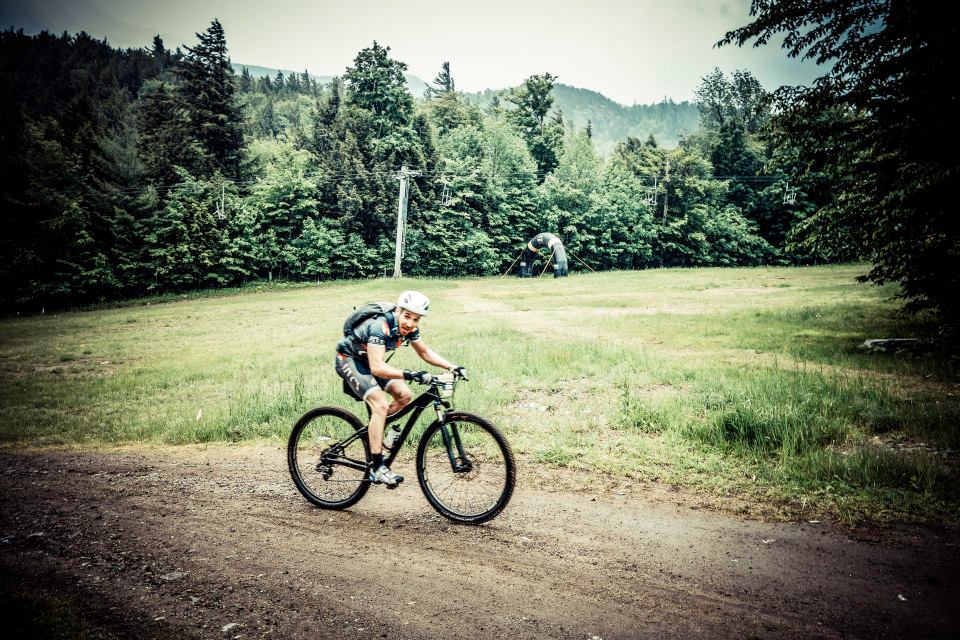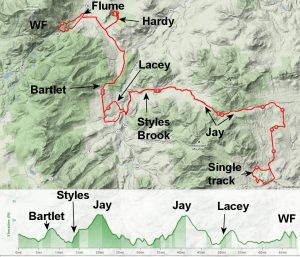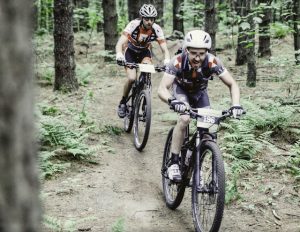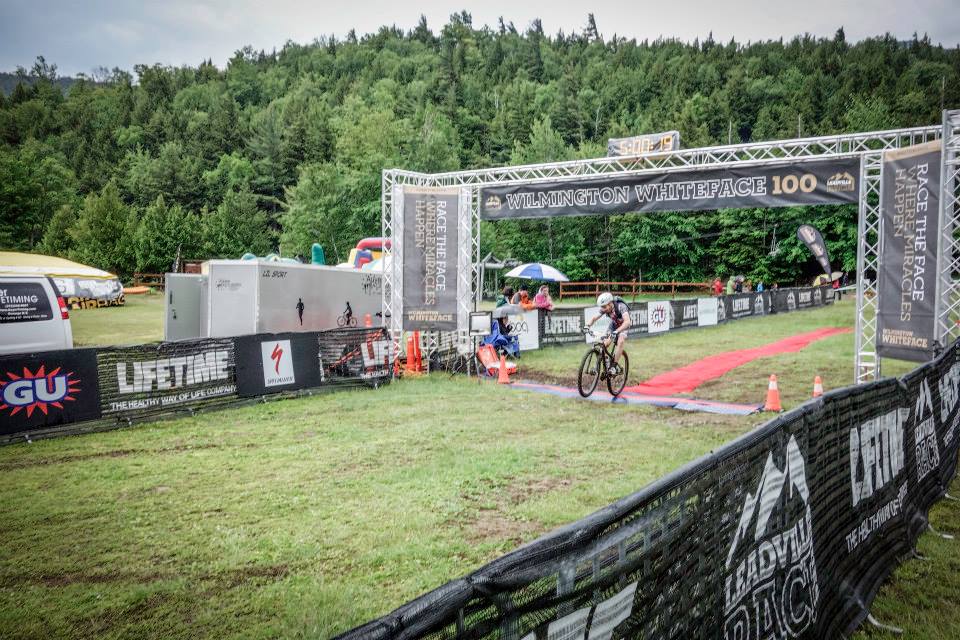if you’ve ever ridden with Greg, you’ve probably watched him zoom away on every significant uphill. So, it should come as little surprise that he put his climbing skills to the test in a grueling 100km mountain bike race and came away with a qualifying time for the mother of all mountain bike races, the Leadville Trail 100. Here’s Greg’s detailed account of how he got there and what he learned along the way.

Background:
The Wilmington Whiteface “100k” Mountain Bike Race may not a triathlon, but it is a very enjoyable race- and it is the only Leadville Trail 100 qualifier in the east.
The official website presents the following description of this race: “The Adirondack region in northeastern New York is a recreational paradise of high rocky summits and breathtaking vistas — both of which factor into the sadistic mountain bike race known as the Wilmington Whiteface 100K, part of the Wilmington Whiteface Bike Fest. Where Olympic heroes once skied down the greatest vertical drop east of the Rockies, you will face a decidedly different direction. Straight up. Good luck with all that.”
As many of you may know, from experience with the Lake Placid IM, the setting for this race is breathtaking. As lucky as I have been to participate in many scenic events, I have to say this one definitely ranks near the top for me so far. Even if you are just going to visit or spectate, the Lake Placid area offers wondrous mountain vistas, trails and roads of all sorts, an inviting culture of athleticism and charming downtowns with plenty of neat dining options.
The Course:
Detailed information about the course is difficult to come by in advance, although the course is well marked and marshalled on race day. I made one trip to the area for a pre-ride (highly recommended), but was unable to ride the entire course due to snowed-over summits. In a nutshell, the course is 69 miles long, with about 8,500 feet of climbing. Most of the course is run on dirt roads, with 4 short sections of single track (for the most part not super “techy”) and a few good stretches of paved road. By and large, this race does not require well developed technical handling skills; it is more about the engine.

The major sections of the ride breakdown as follows:
Start (base of Whiteface):
7am mass start. Staging is first come first serve, which makes for an interesting quandary in a race like this (estimated time for me was 5.5 to 6 hrs). Do you line up early and near the front so you are one of the first to hit the Bartlett hill climb (which is a bit of a bottleneck)? Or, do you do as I did and sit back to allow all the rabbits to blow each other up in the first few miles? I think the best answer is somewhere in between; line up in the front third and be sure to not get sucked up into the parade of race day heroes.
Gun goes off. Head out on paved roads for a fast (and crowded) 5-mile ride to the base of Bartlett. If you are smart, you can catch a ride on someone’s wheel (or hop from wheel to wheel) for most all of the paved stretch leading to Barlett. I barely spun my legs but was able to sit in for 20-23mph in this stretch.
Bartlett:
Once you hit Bartlett, be prepared for a bit of a mess—it should be manageable, but it is still a mess. Unless you are right up front, you are likely to encounter a wall of people who went out too fast for their britches. Find your climbing gear, pick a line, take in the symphony of heavy breathing surrounding you, and start weaving your way through the crowd. I don’t know how many people I passed in this manner, but it was very likely 100 or so.
Barlett is really not a bad climb at all (Cat 3)- it is gradual (avg 5% over 2 miles), in good condition (though dirt) and wide enough to pass with care (watch for soft shoulders). The descent is not bad, but be sure to keep an eye out for rough spots in the road. There are also a few turns that warrant caution, including a 90-degree turn at the end. From the base of Barlett, a short and partially paved section leads to the start of the Styles Brook climb. I will caution that there are a few tricky turns on Line Kiln road on the way to 9N—keep your head up. 9N is a nicely paved road with a slight uphill grade (on the outbound leg); this is a good place to get in some nutrition (I took one gel) before hitting Styles Brook. It also helps to find a wheel to sit on or work with for this stretch.

Styles Brook:
Shortly after you hit Styles Brook, there will be no doubt you are climbing. Though paved, Styles Brook is a pitchy Cat 3 climb; the average grade is over 7%, but that doesn’t do justice to the steeper sections. The strava segment is 2 miles. Once you hit the top of Styles, you will find a nice flat section (turning to dirt). Beautiful views await you here, as you make your way to the start of the outbound Jay mtn climb. Find wheels to work with if you can. And, smile/grimace for the cameras…
Jay Mountain (outbound): The outbound climb on Jay Mountain Road is not horrendous. It is another Cat 3 climb, which, at this point in the race, feels like old hat. Outbound Jay is more sustained (less pitchy) than Styles Brook, but it is dirt. The only steep section comes near the end; most of the rest is 5-7%. The distance is about the same as the previous climbs (~2 miles). The descent off Jay is WICKED long guy! It also has a few hairy corners, so stay awake! Once you hit the base of Jay you will continue to descend, though far more moderately, until you hit the first single track section right before the turn around.
Single track #1 (backside of Jay): This single track is not super technical, but it does throw a few steep (short and punchy) dirt climbs at you (Cat 4 when all put together). The trails are pretty typical for the Northeast—expect roots and rocks (good reasons for reinforced sidewalls!), but nothing too crazy. You’re in the woods here for ~2 miles. Once you exit the trails, you will find an aid station and the turnaround point—get ready to climb again.
Jay Mountain (in bound): You will now go back up the way you came (watch out for racers still outbound). In other words, the never ending descent is now the never ending climb. Sit in and grind away at this Cat 2 energy zapper. 8.6 miles with an average grade of 3.4% (again, not doing justice to the steeper pitches). Make sure to keep your head up for those still descending on the narrower dirt sections of Jay Mountain Rd. Eat when it is easy to breath…
The descent of the front side of Jay is not bad, but use caution as it is dirt and does have a few dips and washboards (will change from year to year, of course). At the bottom of Jay, you will retrace the beautiful flat to the top of Styles Brook (I was cramping nicely by this point). Styles brook is a FAST and flowly 50+mph descent on nice paved road. There is at least one tricky corner, so pay attention. At the base of Styles brook you will backtrack on paved 9N (note, “N” here does NOT indicate north) on a mostly (though very gradually) descending route to Lacey road. If you can get a wheel to help with this paved section, that would be advised…I was solo.
Lacey: Instead of backtracking up all of Bartlett, you will take Lacey Road (Cat 4, by itself) for most of the climb back toward Wilmington/Whiteface. This is a dirt road with a moderate grade. At the top of Lacey, there is another aid station (I refilled my frame-mount bottle with sports drink here). At the aid station you will turn right to climb the remaining section of Bartlett Road. Climbing here is on a decent dirt road (a few loose section on steeper pitches), but not really too bad. Your legs will burn, but that is all part of the game. All together (Lacey + the top section of Bartlett), is a Cat 3 climb over 3 miles with an average grade of 4.6%.
The descent off Bartlett is mellow by mountain bike standards. It is dirt though, so take it easy and be prepared for loose stones and soft margins. Once you hit the end of Bartlett, you will take a left and head out on paved roads (slightly climbing) to the Hardy Rd. Single track. If you can, find wheels to work with on your way to the single track (I did). Taking in a good amount of sports drink between the previous aid station (top of Lacey) and the start of the single track seemed to help with my cramping.

Single Track #2 (Hardy road):The single track here is split into two sections. The first section is on the rider right side of Hardy road; this section is beautiful! Unlike most New England single track, this trail is wonderfully “flowy” with very few roots and rocks (though there are a few). It is serpentine, yet mostly smooth. The second section (on the opposite side of Hardy Rd.) is also beautiful, though it is a little more technical ( a few more roots and rocks, plus slight elevation changes) than the first section; it is still really tame compared to much of what I am forced to ride in NH. It had started to rain at this point so the trails were getting slick. I also ran into a pedal/cleat issue (I should have foreseen this!), which did present a few challenges for the remainder of the race. Once you exit the hardy trails, you will follow nicely paved roads to the “flume” trail system.
Single Track #3 (flume): This stretch barely counts as single track. It is really a double track (carriage road) that climbs to Whiteface. By and large, there is nothing technical here, although the terrain can be loose and gravely. I had a couple of problems here due to my pedal/cleat inadvertently unclipping, but it would otherwise have been a relative cakewalk. At the top of this short double track section you will emerge onto a Whiteface service road, which you will continue to climb for what is probably less than 0.5 miles. The terrain is a little loose, but it is not very steep. (You are not going to the summit of Whiteface(!), as was the case in years past). Given how easy the Whiteface climbing is, I am somewhat disappointed that I held as much in the tank as I did for this climb—it was really not bad. Once you hit the top of the climb, you will descend on rough and LOOSE service road. This was unpleasant, but very ride-able; just use caution. At the end of the service road portion, you are shot off into a short descending (and, relatively speaking, quite technical) single track. Be sure to check your speed as you end the service road descent (it is an abrupt transition to trail)!
Final Single Track 1st Pass (white face/white knuckle): I am not a technical rider, but I think the consensus is that this section is very challenging (I agree, and not in the good way). You enter the single track descending with a sweeping left hand turn. You are then forced up a steep and loose hill, followed by a short and scary descent (read: Freefall) over large roots and rocks. My pedal inadvertently clipped out right at the start of this drop and I ended up riding the top tube all the way down this short snarl of slick man eaters. Fortunately, I survived and quickly hopped back on to finish the rolling and muddy remainder of the trail (with only one more inopportune clip out). At the end of the trail you are dumped out onto a ski trail to follow a gravel path down toward the finish line. The descent is loose, and there is a hairpin corner at the end, so be careful.
But, NOT SO FAST….you get do this Whiteface thing one more time! (It seems to me, bringing riders so close to the finish line just to usher them back up the mountain should fall under the ‘cruel and unusual’ proscriptions of the 8th Amendment…)
On your first pass through the finish area, you are diverted with a very sharp and loose left hand turn (right before the finishing corral) back up Whiteface. You will be climbing up a different way, for much of it though. This time you will follow service road that starts off moderately climbing, but will soon turn to a fairly steep dirt ascent. Everyone around me ended up walking this steep pitch. Thanks to my easy gearing choice though, I was able to ride up cleanly. Needless to say, this allowed me to make several passes. Once you reach the top of the steep pitch, you will turn left and continue climbing on the service road sections you took up the first time. This second climb (all together) is Cat 4, with an average grade of 10% over 0.8 miles. From here to the end, it is groundhog day; same descent and same single track.
Final Single Track 2nd Pass (Whiteface again): The same thing as last time. With a bit of luck (and lots of concentrated effort), I managed to stay in my pedals this time. I made it through and cruised (carefully) to the finish line.
Total time:
5:00:19. (good enough to qualify for Leadville!…barely) Many thanks to Coach Colin Cook and all my training partners for helping to make this happen!

Lessons Learned:
1) EQUIPMENT PROBLEMS: I knew I had issues with my pedals, yet I didn’t take the time to sort them out before the race; this hurt me (almost literally). To some degree, this is a function of cramped time constraints, but I should have made time to properly fix this. Were it not for my pedal issue, I’m sure I would have broken the 5hr mark, saved myself considerable frustration (and nearly bodily harm), and instilled more confidence in myself and my equipment at critical moments in the race. Long story longer, don’t ignore equipment issues; nip them in the bud.
2) PRE-RIDE: Pre-riding the portion of the course I did was invaluable. However, since I didn’t know what to expect on the portions I missed, I ended up holding too much in the tank for the final climb. Whenever possible, pre-ride the whole course.
3) GEARING: For this race, I highly recommend light gearing. As witnessed by my ‘cleaning’ the final climb up Whiteface, light gearing is super helpful on the steeps. (specifics on gearing below)
4) SPORTS DRINK: I took a diluted sports drink mix with me on my downtube bottle cage. Although I prefer the taste of diluted sports drink, I think a fully leaded version is needed for a race like this— as noted, I started to cramp around the two-thirds mark in the race, which seems to have been rectified by (or at least correlated with) refueling with full-bodied sports drink starting at the top of the Lacey Rd. climb. I should also not that I took a risk imbibing this sports drink, as I had no idea what it was…and probably had no experience with it.
5) NUTRITION OPPORTUNITIES: Nutrition can be tough in a race like this. I had reminders set for every 40 min, however, it seemed as if those reminders always went off when I was barreling down a sketchy descent or weaving my way through tight trees. Try to keep an eye on the clock when you anticipate a change in environment which may forestall an upcoming nutrition cycle—t may be better to take in some calories or sports drink slightly ahead of schedule if you will soon be plunging into a white-knuckle abyss.
6) TRAINING: Training for an event like this takes a crazy amount of time on the bike. In my case, I was lucky enough to have a great coach (Colin Cook) and motivated training partners (NEMS, Goodales, as well as Andy and Cristina King). Altogether, these assets helped tremendously; this is one of the greatest (selfish) reasons to maintain an active role in organizations like NEMS—you get pushed, you push, you laugh, you cry….but at the end of the day you will have stronger friendships and will have accomplished things which would have been much more difficult on your own.
I should also note that feedback from other locals (John Wilson, in particular) was very helpful in preparing for the sections of the course I was unable to pre-ride. Talking with other athletes, is always helpful. Many thanks to all who helped make this happen.
Equipment Notes:
Bike: Specialized Stumpjumper (alloy) hard-tail 29’er (with suspension fork)
Tires: I chose to use a moderate tread up front (Continental Mountain King), paired with a non-aggressive rear tire (Continental Race King). I ran both tires tubeless on the stock DT swiss rims. Both tires have reinforced sidewalls (recommended). I had no traction issues.
Gearing: I ran with very light gearing (22-36 up front, with an 11-36T cassette), which I was grateful to have on the second climb up Whiteface.
Hydration: Camelback! I don’t ordinarily like wearing these, but I think it is the only way to reliably stay hydrated on a ride like this (drinking from a downtube bottle cage is very tough on choppy terrain). I also had a short water bottle mounted on my downtube for sports drink.
Happy and safe training!
-Greg
